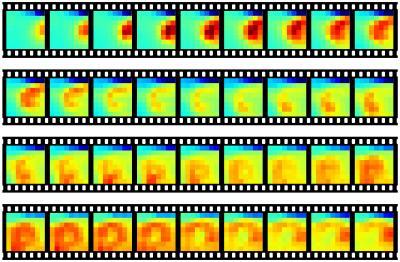This news release is available in German.
When we drift into deep slow-wave sleep (SWS), waves of neuronal activity wash across our neocortex. Birds also engage in SWS, but they lack this particular brain structure. Researchers from the Max Planck Institute for Ornithology in Seewiesen, Germany together with colleagues from the Netherlands and Australia have gained deeper insight into the sleeping avian brain. They found complex 3D plumes of brain activity propagating through the brain that clearly differed from the two-dimensional activity found in mammals. These findings show that the layered neuronal organization of the neocortex is not required for waves to propagate, and raise the intriguing possibility that the 3D plumes of activity perform computations not found in mammals.
Mammals, including humans, depend upon the processing power of the neocortex to solve complex cognitive tasks. This part of the brain also plays an important role in sleep. During SWS, slow neuronal oscillations propagate across the neocortex as a traveling wave, much like sports fans performing the wave in a stadium. It is thought that this wave might be involved in coordinating the processing of information in distant brain regions. Birds have mammalian-like cognitive abilities, but yet different neuronal organization. They lack the elegant layered arrangement of neurons characteristic of the neocortex. Instead, homologous neurons are packaged in unlayered, seemingly poorly structured nuclear masses of neurons.
Researchers from the Max Planck Institute for Ornithology in Seewiesen together with colleagues from the Netherlands and Australia now investigated in female zebra finches how brain activity changed over space and time during sleep. "When we first looked at the recordings, it appeared that the slow waves were occurring simultaneously in all recording sites.
However, when we visualized the data as a movie and slowed it down, a fascinating picture emerged!" says Gabriël Beckers from Utrecht University, who developed the high-resolution recording method at the Max Planck Institute for Ornithology in Seewiesen. The waves were moving across the two-dimensional recording array as rapidly changing arcs of activity. Rotating the orientation of the array by 90 degrees revealed similar patterns, and thereby established the 3D nature of the plumes propagating through the brain. The researchers found similar patterns in distant brain regions involved in processing different types of information, suggesting that this type of activity is a general feature of the sleeping avian brain.

A series of images (start, top left; end, bottom right) showing neuronal activity moving through the brain. Each image shows activity recorded at 64 points (8 x 8 grid) with more red colors indicating higher activity. At the start, a wave of activity sweeps across the recording array in a right to left direction and then dissipates. The wave then emerges again near the bottom center of the array and expands outward as a ring of activity as the plume passes perpendicular to the plane of the array.
(Photo Credit: MPI f. Ornithology/ Rattenborg)
In addition to revealing how neurons in the avian brain behave during sleep, this research also adds to our understanding of the sleeping neocortex. "Our findings demonstrate that the traveling nature of slow waves is not dependent upon the layered organization of neurons found in the neocortex, and is unlikely to be involved in functions unique to this pattern of neuronal organization," says Niels Rattenborg, head of the Avian Sleep Group in Seewiesen. "In this respect, research on birds refines our understanding of what is and is not special about the neocortex." Finally, the researchers wonder whether the 3D geometry of wave propagation in the avian brain reflects computational properties not found in the neocortex. While this idea is clearly speculative, the authors note that during the course of evolution, birds replaced the three-layered cortex present in their reptilian ancestors with nuclear brain structures. "Presumably, there are benefits to the seemingly disorganized, nuclear arrangement of neurons in the avian brain that we are far from understanding. Whether this relates to what we have observed in the sleeping bird brain is a wide open question," says Rattenborg.




Comments